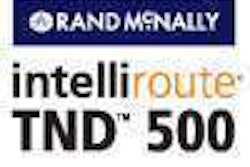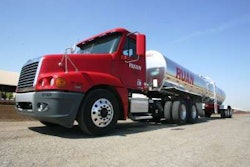The biggest change facing heavy-duty trucks for 2010 involves new technologies designed to meet the U.S. Environmental Protection Agency’s tighter emissions standards. Beyond that, there are several new models and other touchups worth noting, such as new standard positions, safety features and options.
To view a PDF of the Class 7-8 specs, click here. Here are some highlights of what to expect:
Ford: The company reaffirmed its commitment to the North American Class 6 and 7 truck markets, announcing the continued production of F-650 and F-750 Super Duty trucks through its Blue Diamond collaboration with Navistar. Navistar acquired additional equity in Blue Diamond, which will continue to offer dealers and customers F-650 and F-750 trucks, as well as parts support.
Eaton Corp.’s UltraShift Highway Value (HV) transmission now is available as a data book option for the F-650 and F-750. Eaton says the fully automated transmission for Class 6 and 7 vehicles with diesel engines in the 195 to 260 horsepower range is capable of handling torque capacities up to 660 pounds per foot and loads up to 33,000 pounds gross vehicle weight, and is suited for pickup-and-delivery, service/utility and recovery applications.
Freightliner: Daimler Trucks North America announced surcharges of $9,000 per vehicle for meeting 2010 standards with its BlueTec selective catalytic reduction (SCR) emissions technology on vehicles equipped with Detroit Diesel DD15 and DD16 big bore engines, as well as the medium bore DD13; a $9,000 surcharge also will be added to new SCR-equipped vehicles with Cummins’ ISX15 engine. A surcharge of $7,300 will be added to vehicles equipped with the Cummins ISC8.3 engine, and a $6,700 surcharge will be added to vehicles with Cummins ISB6.7 engines.
Daimler says Detroit Diesel BlueTec fuel efficiencies are the result of three optimization factors: base engine-out nitrogen oxide (NOx) levels, diesel particulate filter (DPF) regeneration intervals and exhaust back pressure. In addition, reduced reliance on exhaust gas recirculation (EGR) lowers heat rejection, meaning no expansion of cooling capacity and no resulting impact on aerodynamics or underhood packaging.
Freightliner says its revamped on-highway Coronado features enhanced aerodynamics, updated technological innovations and luxurious styling, and also features improved fuel economy and revamped comfort features; and that its new Coronado Severe Duty (SD) – available in both set-back and set-forward axle configurations – improves upon the durability and dependability of its FLD SD with the driver comfort and style expected from the Coronado, while adding new elements specifically engineered for the vocational market. The Coronado SD replaces the FLD SD. (For more details on the Coronado models, see Products, page 66.)
Freightliner introduced its first natural gas-powered truck, the Freightliner Business Class M2 112 NG, aimed at emissions-sensitive applications like port operations, natural gas utilities and municipalities. The OEM factory-built truck is powered by the Cummins Westport ISL G.
The Holland FWAL lightweight forged aluminum fifth wheel – developed through an engineering collaboration between SAF-Holland and Alcoa – now is offered as an option on Freightliner long-haul and heavy-duty models. Also, Roadranger Fuel Efficient (FE) 75w-90 Synthetic Axle Lubricant is now a factory-installed option on the Cascadia, Coronado, Columbia and Century Class S/T trucks.
International: Navistar, which has shunned SCR technology, announced that prices for International trucks equipped with MaxxForce 11 and 13 big bore advanced exhaust gas recirculation (EGR) diesel engines will increase $8,000, while prices for trucks equipped with the MaxxForce 7, DT, 9 and 10 will increase $6,000. Navistar says its MaxxForce advanced EGR engines feature improvements in fuel injection, air intake management, electronic calibration and proprietary combustion technology. Navistar will use a two-stage EGR cooler that it says will produce cooler air than the current engine.
The company is working with Caterpillar in producing the 15-liter version of the MaxxForce engine – leveraging various components of the Caterpillar C15 – but the necessary testing, verification and certification means the engine won’t be available until early 2011. As a bridge, Navistar will use Cummins ISX engines built in 2009 to the extent allowed by EPA, and the MaxxForce 13 will be used for applications that don’t require 15-liter power.
WorkStar fire trucks and emergency vehicles now offer a factory-installed vehicle data recorder fully compliant with National Fire Protection Association standards. Also, WorkStar severe-service trucks now offer the Bendix ESP Electronic Stability Program, an ABS-based truck stability system suited for a variety of applications.
BorgWarner’s Cool Logic variable speed fan drives now are available as an option on the ProStar.
Kenworth: The company, which will use SCR technology in all of its heavy-duty products, introduced the T470 model, suited for snowplow, dump, mixer, winch, refuse and other heavy front-axle vocational and municipal applications; and the T440 model in tractor and truck configurations for regional haul, city pickup-and-delivery, municipal and vocational applications, in addition to heavy front-axle markets such as dumps, mixers and fire trucks. (For more details on the T440 model, see Products, page 70.)
Kenworth’s T800 Liquefied Natural Gas (LNG) trucks for port, freight and vocational applications are equipped with the Westport LNG fuel system and Westport GX 15-liter engine, which meets EPA and California Air Resources Board emissions certification standards.
The AG130 front air suspension – available in 12,000-lb. and 13,200-lb. ratings for the T660, T800 and T2000 Class 8 models – features a four air-bag configuration designed to allow the suspension to resist high input torque encountered with disc brakes. The disc brake-compatible AG400L tandem rear four-bag suspension – a 40,000-lb. rated highway rear suspension system for the T660, T800, T2000 and W900 models – is suited for over-the-road and pickup-and-delivery applications.
Allison Transmission’s Load-Based Shift Scheduling (LBSS) – designed to select between economy and performance shift schedules automatically based on the vehicle’s actual payload and its operating grade – is a standard feature on select Kenworth trucks equipped with Allison transmissions.
Mack: Mack will use SCR aftertreatment and will add between $9,600 and $9,800 to prices for 2010 SCR-equipped trucks. Mack selected Terra Environmental Technologies Inc. as its preferred DEF supplier; TET will supply all new Mack trucks with an initial fill of TerraCair DEF at the time of assembly and provide Mack dealers with the product in portable 1- and 2.5-gallon containers.
The Mack Road Stability Advantage System (RSA) by Bendix – now available on Class 8 highway models – integrates the throttle, engine brakes and foundation brakes into the truck’s cruise control function. A radar sensor located in the truck’s front bumper identifies and tracks moving objects in front of the truck. Once the driver turns the cruise control on and sets a speed, ACC works to maintain a set time gap between the truck and the vehicle in front of it. If the vehicle in front of the truck slows, the system picks up on the decreasing time interval between them and begins to reduce the throttle to compensate. If that is not enough, the ACC then will apply about one-third of the foundation brake capacity. The system is proactive enough to bring the truck to a complete stop on its own without driver input should the situation demand it.
TerraPro Low Entry and Cabover refuse models now are available with heavy-duty natural gas engines. The 9-liter Cummins Westport ISL G is rated at 320 hp, can use LNG or compressed natural gas (CNG), and has a three-way catalytic converter.
Peterbilt: The company’s heavy-duty trucks will rely on SCR technology for 2010 emissions compliance. A fuel efficiency package for Models 385, 386, 388 and 389 includes aerodynamic mirrors, sleeper extender, roof fairing and trim tabs, composite sunvisor and a sleeper roof transition to redirect airflow and provide less drag resistance, resulting in improved overall fuel economy and a more streamlined appearance. The fuel efficiency package also will be available from Paccar Parts for Models 388 and 389, as well as earlier Models 378 and 379. A proprietary aerodynamic package for Models 386 and 384 adds enhanced chassis fairings and aero battery box/toolbox and also is available from Paccar Parts for retrofit.
New interior designs for Models 386, 384, 389, 388, 367 and 365 include the Platinum interior for the ultimate in luxury, Prestige for contemporary and cost-efficient operation, and ProBilt for customers who demand rugged efficiency; additionally, all new interiors are equipped with a new HVAC system.
Peterbilt introduced two new trucks: Model 337, which replaces Model 335 and expands the company’s medium-duty presence and is suited for pickup-and-delivery, beverage and food service vocations; and Model 348, which replaces Model 340 and is designed for the Class 7-8 specialty application market. (For more details on Models 337 and 348, see Products, page 66.)
The company also is taking orders for the production of its vocational and aerodynamic vehicles powered by CNG and LNG; the Model 365 and Model 384 will be offered with the Cummins Westport ISL G, providing 320 hp and 1,000 lb-ft of torque. The Model 365 NG is available in both set-forward and set-back axle configurations, while the ISL G-powered Model 384 is designed to provide a clean-burning aerodynamic platform for a wide variety of customer applications, including line, bulk and tanker hauling.
Allison’s LBSS is available on Peterbilt’s aerodynamic, traditional, medium-duty and vocational trucks equipped with Allison fully automatic transmissions.
Volvo: Volvo Trucks North America, which will use SCR aftertreatment, will add $9,600 to prices for 2010 trucks built with Volvo D11, D13 and D16 engines, as well as those with the Cummins ISX. The company says its SCR-equipped trucks will not require active regeneration of DPFs during normal highway operating conditions; thanks to the 2010 integration of Volvo’s SCR and DPF technologies, passive regeneration cycles will eliminate the need to inject diesel fuel into the DPF to oxidize accumulated soot, resulting in reduced fuel consumption, reduced thermal cycling of expensive catalysts and lower overall operating costs. Volvo says this also relieves the driver of having to keep track of when an active regeneration needs to take place.
Volvo Enhanced Cruise (VEC) – a Class 8 option developed with Bendix – is designed to work in conjunction with the truck’s adaptive cruise control system. A sensor located in the truck’s front bumper projects a 16-degree radar cone in front of the truck that can track up to 32 different objects within about 500 feet of the vehicle. Once the driver turns the cruise control on and sets a speed, VEC maintains a set time gap between the truck and the vehicle in front of it. The system can detect a decreasing time interval between the truck and the vehicle and automatically reduce the throttle or bring the truck to a complete stop on its own.
Western Star: The Detroit Diesel DD16 engine will be in production for the Western Star 4900 series in March 2010 and the Western Star 6900 in July 2010. Equipped with SCR-based BlueTec emissions technology, the DD16 displaces 15.6 liters and is suited for owner-operators, small fleets and specialty applications that include the mining, petroleum, agriculture, logging, hazardous material and heavy-haul segments. The DD16 – which will be offered with a large variety of output and multitorque power ratings from 1,750 to 2,050 lb-ft torque and 475 to 600 hp – has enough pulling power to allow the driver to haul heavier payloads up and down the steepest grades and hang in top gear longer, and thanks to the DD16’s integrated engine brake, getting down the other side is just as easy.
A new configuration option for the company’s 4900 FA model series is geared toward construction and severe-duty applications such as West Coast mixers and super dumps. The truck maker says the new set-forward 109-inch BBC twin steer features a three-degree wheel cut improvement over previous designs, offering greater maneuverability for offroad applications.












